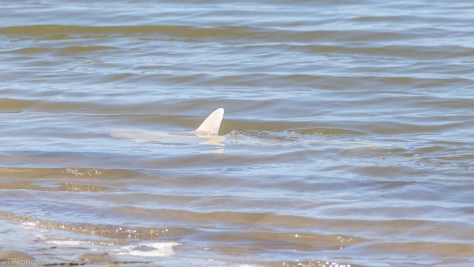No more than 3 feet (1 m) from shore. You can see the wake hitting the sand. Please…no toes in the water.

There is a slope here which is why Dolphin swim on shore catching fish. Funny thing was a few minutes before someone had asked about ever seeing sharks in the water. They were told no.

I am standing on the waters edge so I can see the shark dorsal and unique shark gills.

Enlarge the photograph above to view shark gills.

I moved along with him to get this angle so I could document how close to shore they are hunting now.
I repeat from other articles… never dull out there.


That is freaky!
Yep… just updated the article with another photograph I had taken. The water drops off there, which is why 13 foot Dolphins can hunt there too. Unfortunately I did not get a good view of his head. We have Hammerheads and Boneheads in these inlets. Doing this is a lot more fun than other types of photography 🙂
I bet it is fun! I’ve been following your photos of the dolphins coming to shore… it’s pretty fascinating. I didn’t know they did that!
Only a very few know how. This Dolphin Pod has learned and passed it to the young. The Lowcountry (coastal South Carolina and Northern Georgia) is the only place this happens in North America. I have heard of a few in South America, and off the coast of Portugal. A conservation group is tracking the Dolphin by their dorsal fins. A Dolphin that has been taught this will have one side of the fin rubbed smooth by the sand. We shoot the dorsal fins and if lucky will be there during a stranding.
Thanks for sharing it with us! 😁 it’s really fascinating!
Scarrrryyy!
Close, but I was on shore.
Never dull😏 Do the sharks ever challenge the dolphins I wonder…
Here I would doubt it. They are outnumbered and Dolphin hunt in packs. There are young Dolphin here though. Out a sea it would be different.